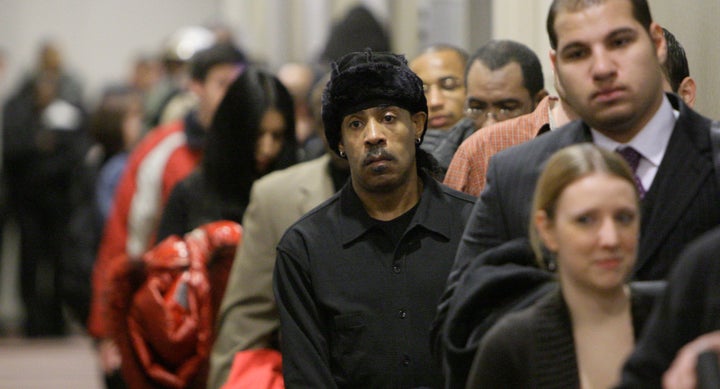
America's current unemployment crisis is predominately the result of a pronounced dip in the business cycle, according to a new paper by economists at the International Monetary Fund. But, structural factors, like shortages of highly-skilled laborers, is keeping the jobless rate high, too, the paper finds.
The authors of the IMF working paper, entitled "New Evidence on Cyclical and Structural Sources of Unemployment," argue that roughly 75 percent of average unemployment is due to a lack of demand in the economy, 25 percent a result of workers not possessing desirable skills.
In other words, the wave of joblessness in America is mostly due to cyclical factors, not inherent structural weaknesses, the paper finds.
The causes of persistently high unemployment since the financial crisis are still a matter of debate. Paul Krugman wrote last September that "structural unemployment is a fake problem, which mainly serves as an excuse for not pursuing real solutions."
Since the financial crisis, a rising unemployment rate has transformed into an all-out unemployment crisis, reaching 10.1 percent in late 2009 from 4.4 percent just two and a half years earlier. By April 2011, it had dropped only somewhat, to 9.0 percent.
The report contends the Great Recession closely mirrors the recession of 1973-1975, another period when shocks to various industrial sectors also played a large role in the rising unemployment.
Long-term unemployment has become a critical problem in the U.S: the average length of unemployment between jobs now exceeds 30 weeks, the report says, which is 10 weeks higher than any other period dating back to the 1960s. The report also cites a 2011 study finding that 20 percent to 25 percent of the recent increase in unemployment can be attributed to "industrial and occupational mismatches" in the workforce, "rather than geographic mismatches."
Over the course of the Great Recession, however, 40 percent of America's country's long-term unemployment crisis comes from a structural mismatches in worker skills, the study finds.
Compounding those structural issues is the foreclosure crisis. Bad housing conditions, the report contends, might "slow the exodus of jobless individuals from a depressed area," making it difficult for people to get to the jobs. That combo -- "skill mismatches and higher foreclosure rates" -- has on its own raised the country's unemployment rate by 1.5 percentage points since the beginning of the crisis, the report says.
And as the length of unemployment increases, the study continues, the already "substantial" effect of structural shocks becomes even "more important," with the worker's change of finding a job dwindling by the day.
Christina Romer, who formerly held a chair President Obama's Council of Economic Advisers, made a similar point in a speech at Washington University in April.
"While I am confident that most of the current elevated unemployment is due to cyclical factors, I am not at all sure that structural unemployment will not become more important going forward," Romer then said. "[S]tructural unemployment has risen somewhat nationwide, and could rise further if we don’t reduce cyclical unemployment quickly[.]"
Combatting that structural unemployment, Romer continued, requires investing in scientific research, better education and programs aimed at helping areas injured by trade. "Some will say that given our desperate long-run fiscal situation, we can't possibly spend more on anything," Romer said "I think this is deeply wrong."
Still, so far, it is the low levels of output associated with cyclical unemployment that has been "clearly the dominant factor" in explaining the unemployment crisis, the report contends. That would indicate that so long as the economy grows, it will bring as least some of America's struggling workforce up with it.
The IMF report stands in contrast to a March report by researchers at the San Francisco Federal Reserve Bank that argues the unemployment crisis to be predominately cyclical. They based their claim on the recent difficulties of young college graduates to find jobs, under the assumption that if the issue is structural, there would still be a demand for college graduates.
Read the working paper below:
